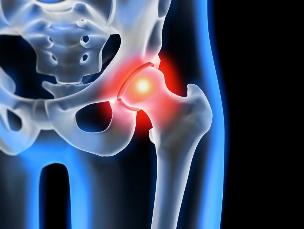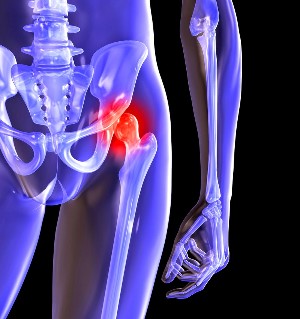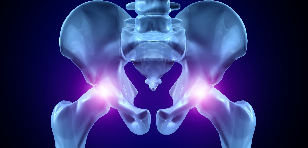Osteoarthritis of the hip joint degenerative pathology, which is characterized by destruction of the hyaline cartilage. The disease develops gradually, associated with pain and decreased range of motion. In the absence of medical intervention at the initial stage of the disease a few years later, there is atrophy of the thigh muscles. The injured limb was shortened, and the fusion of the joint space, leading to a partial, or complete paralysis of the hip joint. Reasons, the pathology becomes the pre-trauma, curvature of the spine, systemic disease of the musculoskeletal system.

The disease is typically diagnosed in patients of middle age and older people. The diagnosis put on the basis of the results of the instrumental investigations — x-ray, MRI, CT, and arthroscopy. Treatment of disease 1 and 2 degrees of severity, and conservative. After the discovery of the ankylosis, and the ineffectiveness of drug therapy, surgery (arthrodesis, arthroplasty).
The mechanism of the development of the pathology
The hip joint consists of two bones — the iliac and femoral. The lower part of the Ilium is her body, who is taking part in the plexus, with the femur, forming the upper part of the acetabulum. During the movement of the stationary the fossa and the femoral head is moving around. This is the "hinge" to the device, the hip joint allows him to bend, stretch, rotate, and to contribute to the call to bring it to the tank. The smooth gliding of the articular structures and provides smooth, elastic, hyaline cartilage lining the socket and the femoral head. Its main function is the redistribution of the loads when they are driving, to prevent the rapid deterioration of the bone tissue.

Under the influence of external or internal factors, of which disturbed trophic cartilage. He didn't have the circulatory system — the nutrients of tissue supplies of synovial fluid. In the case of arthrosis, it thickens and becomes viscous. Lack of nutrients causes a drying of the surface of the hyaline cartilage. It is covered with cracks, which leads to a constant micro-trauma to the tissues in the flexion or extension of the hip joint. The cartilages become thinner, lose its cushioning properties. To "adapt" to the increase of pressure, the bones are deformed. Against the background of worsening of the metabolic rate in the tissues of the progression of the destructive-degenerative changes.
The reasons and factors that lead
Idiopathic or primary osteoarthritis develops without any reason. It is believed that the destruction of the cartilage occurs as a result of the natural aging of the body, slowing down regenerative processes, the breakdown of collagen and other compounds necessary for proper regeneration of the structure of the hip joint. The second disease is going on in the background that is already present in the organism a morbid condition. The most common causes of secondary af include the following:
- pre-injury, — damage to the tendon unit, muscle tears, their complete separation from the bone base fractures, dislocations;
- developmental disorders of the joints, congenital dysplastic disorders;
- autoimmune disease — rheumatoid, reactive, psoriatic arthritis, systemic lupus erythematosus;
- nonspecific inflammatory diseases, for example suppurative arthritis;
- specific infections — gonorrhea, syphilis, brucellosis, anaplasmosis, trichomoniasis, tuberculosis, osteomyelitis, encephalitis;
- the disruption of the functioning of the endocrine system.
- the degenerative pathology — osteochondropathy of the femoral head;
- hypermobility of the joints due to the production of the "super tensile" of the collagen that cause of their excessive mobility, weakness of the ligaments.
As for the reason for the development of the disease it may be hemarthrosis (bleeding into the cavity of the hip joint), the precipitating factors include a violation of hematopoiesis. The conditions for the disease are excess weight, excessive exercise, sedentary way of life. For its development, have led to an organisation of training, the lack of food products with a high content of vitamins, fat and water soluble vitamins. Postoperative arthrosis occurs a few years after the surgical intervention, especially if it was accompanied by the excision of a large volume of tissue. Osteoarthritis of the hip joint can be passed on by inheritance. However, in the presence of certain inborn traits (violation of metabolism, the structure of the skeleton), the likelihood of its development is substantially increased.
Symptoms
The leading signs and symptoms of osteoarthritis of the hip joint pain when walking in the thigh, the knee joint. A person suffering from stiffness in the limbs, stiffness especially in the morning. To stabilize the joint, and the patient begins to limp, his movements changed. With the passage of time, due to muscle atrophy and deformation of the joint of the limb is considerably shortened. The other feature of pathology — limitation of hip abduction. For example, the difficulties encountered in the process of trying to sit on a chair, legs apart to the sides.

You started a" ARTHRITIS, can be treated at home! Just remember, once a day to smear it...
For arthrosis of the first order, and is characterized by a recurring pain that occurs after intensive physical loads. They are located in the area of the articulation, and disappear after a long vacation.
In the second instance the disease of the hip joints the pain intensity increases. The interference happens even at rest, it will be applied to the hip and groin, worse when lifting weights or increasing physical activity. To address hip pain, a person begins a barely noticeable limp. Marked limitation of motion of the joints, especially in abduction and internal rotation of the hip.
Arthrosis of the third degree is characterized by persistent abdominal pain. When you're driving, it is difficult, therefore, when walking on a man is forced to use a cane or crutches. Due to the weakness of the abductor muscles of the hip is the offset of the pelvic bone in the frontal plane. To compensate for the occurred reduction of the legs of the patient when the movement is tilted toward the affected limb. This causes a shift of the center of gravity, and the increased stress on the joint. At this stage of the arthrosis develops a pronounced ankylosis of the joint.
| Level | Radiographic signs |
| The first | The changes are expressed not sharply. The articular slits the sides, irregularly constricted, there is no destruction of the surface of the femur. On the outer or inner rim of the acetabulum, there was a small bony growths |
| The second | The height of the joint space is significantly reduced due to its uneven joints. The bones of the head of the femur is displaced upward, deformed, enhanced, and its contours become uneven. Osteophytes are formed on the surface of the inner and outer edges of the fossa of the |
| The third | There is a complete or a partial fusion of the joint space. The head of the femur is strongly expanded. Multiple bony nodules situated on the surface of the acetabulum |
The diagnosis
In the process of setting a diagnosis, the physician relies on the clinical manifestations of the disease, anamnesis, external examination of the patient and instrumental examinations. The most current radiographs. With his help, it has been estimated that the state of the hip-joint, that set the stage for its object, to the extent of the damage to the cartilage tissue and, in some cases, the cause of the issues. If the cervico-diaphyseal of the nodes is increased, and the acetabulum is flattened and beveled, then with high probability it is possible to assume congenital dysplastic changes in the joints. In Perthes disease, showing the broken form of the thigh bone. The X-ray that allows for the identification and preparation of post-traumatic osteoarthritis, and, in spite of the lack of a history of a previous disease of injury. Also, use other diagnostic methods:
- CT helps to detect growths on the edges of the plates of bone formed osteophytes;
- The MRI is carried out to assess the condition of the body's connective tissue structures and the extent of their involvement in the pathological process.
If necessary, the inner surface of the joint is examined with the aid of an arthroscopic instrument. The differential diagnosis done to rule out osteoarthritis, lumbar-sacral or thoracic degenerative disc disease. The pain in the disease may masquerade as clinical signs of a radicular syndrome is caused by pinching or inflammation of a nerve. To exclude a neurogenic pathology, usually through a series of tests. Osteoarthritis of the hip joint necessary differentialsa on top of the bursitis of the hip, ankylosing spondylitis, reactive arthritis. To exclude any autoimmune pathologies and performed biochemical studies in the blood and in the synovial fluid.
Surgery
With the ineffectiveness of conservative therapy, Il-diagnosing complicated pathology surgery performed. To restore the cartilage in joints damaged by arthritis, no surgeries possible, but you have the right of access to, treatment in, and in accordance with all health codes, maintain proper lifestyle, medical gymnastics, attend courses of massage, the intake of vitamins and proper diet you can stop the process of destruction, and the destruction of the cartilage and the hip joint.

































